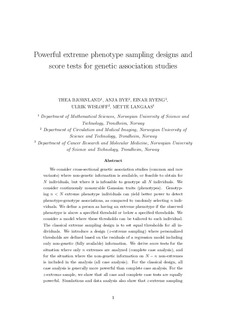| dc.contributor.author | Bjørnland, Thea | |
| dc.contributor.author | Bye, Anja | |
| dc.contributor.author | Ryeng, Einar | |
| dc.contributor.author | Wisløff, Ulrik | |
| dc.contributor.author | Langaas, Mette | |
| dc.date.accessioned | 2019-02-13T15:00:29Z | |
| dc.date.available | 2019-02-13T15:00:29Z | |
| dc.date.created | 2018-08-10T10:28:06Z | |
| dc.date.issued | 2018 | |
| dc.identifier.citation | Statistics in Medicine. 2018, 37 (28), 4234-4251. | nb_NO |
| dc.identifier.issn | 0277-6715 | |
| dc.identifier.uri | http://hdl.handle.net/11250/2585308 | |
| dc.description.abstract | We consider cross‐sectional genetic association studies (common and rare variants) where non‐genetic information is available or feasible to obtain for N individuals, but where it is infeasible to genotype all N individuals. We consider continuously measurable Gaussian traits (phenotypes). Genotyping n < N extreme phenotype individuals can yield better power to detect phenotype‐genotype associations, as compared to randomly selecting n individuals. We define a person as having an extreme phenotype if the observed phenotype is above a specified threshold or below a specified threshold. We consider a model where these thresholds can be tailored to each individual. The classical extreme sampling design is to set equal thresholds for all individuals. We introduce a design (z‐extreme sampling) where personalized thresholds are defined based on the residuals of a regression model including only non‐genetic (fully available) information. We derive score tests for the situation where only n extremes are analyzed (complete case analysis) and for the situation where the non‐genetic information on N − n non‐extremes is included in the analysis (all case analysis). For the classical design, all case analysis is generally more powerful than complete case analysis. For the z‐extreme sample, we show that all case and complete case tests are equally powerful. Simulations and data analysis also show that z‐extreme sampling is at least as powerful as the classical extreme sampling design and the classical design is shown to be at times less powerful than random sampling. The method of dichotomizing extreme phenotypes is also discussed. | nb_NO |
| dc.language.iso | eng | nb_NO |
| dc.publisher | Wiley | nb_NO |
| dc.relation.uri | https://doi.org/10.1002/sim.7914 | |
| dc.title | Powerful extreme phenotype sampling designs and score tests for genetic association studies | nb_NO |
| dc.type | Journal article | nb_NO |
| dc.type | Peer reviewed | nb_NO |
| dc.description.version | acceptedVersion | nb_NO |
| dc.source.pagenumber | 4234-4251 | nb_NO |
| dc.source.volume | 37 | nb_NO |
| dc.source.journal | Statistics in Medicine | nb_NO |
| dc.source.issue | 28 | nb_NO |
| dc.identifier.doi | 10.1002/sim.7914 | |
| dc.identifier.cristin | 1600941 | |
| dc.description.localcode | Locked until 7.8.2019 due to copyright restrictions. This is the peer reviewed version of an article, which has been published in final form at [https://doi.org/10.1002/sim.7914]. This article may be used for non-commercial purposes in accordance with Wiley Terms and Conditions for Self-Archiving. | nb_NO |
| cristin.unitcode | 194,63,15,0 | |
| cristin.unitcode | 194,65,25,0 | |
| cristin.unitname | Institutt for matematiske fag | |
| cristin.unitname | Institutt for sirkulasjon og bildediagnostikk | |
| cristin.ispublished | true | |
| cristin.fulltext | postprint | |
| cristin.qualitycode | 2 | |
